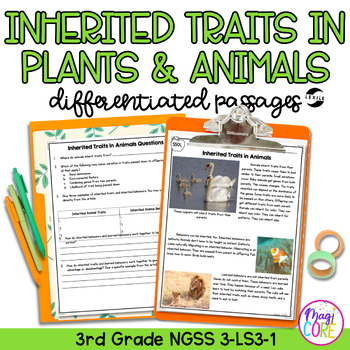Inherited Traits NGSS 3-LS3-1 Science Differentiated Reading Passages
- Zip
What educators are saying
Also included in
- ⭐️This science differentiated passages bundle contains 3rd grade science passages about plant and animal lifecycles, inherited traits in plants and animals, variation, survival, and reproduction, and environmental influence on traits.Key Features:✏️ Convenience - Everything you need for this unit is aPrice $18.00Original Price $20.00Save $2.00
- ⭐️This science differentiated passages bundle contains all of my 3rd grade science passages about ecosystem change, lifecycle & traits, weather & climate, and forces & interaction.Key Features:✏️ Convenience - Everything you need for this unit is all in one place!✏️Engaging - This resourcePrice $60.00Original Price $75.00Save $15.00
Description
⭐️ Build background about hereditary and inherited traits in plants and animals. In these differentiated passages students will read learn to distinguish inherited and acquired traits, analyze how inherited traits help plants and animals survive, and analyze data about inherited traits. Students will read high interest passages to build background about inherited traits in plants and animals, read about Hemingway's Polydactyl Cats, Mendel (the father of genetics), and color variation in flower fields.
⭐️ This unit is perfect for 3rd grade. It was created to align with 3-LS3-1 but can be used in any classroom to teach students about inherited traits in plants and animals.
⭐️Integrates key reading skills, with a focus on making inferences. Incorporates key vocabulary, text features, graphic organizers, and open ended questions.
Key Features:
✏️ Build Background- Reinforce key science topics with real-life passages.
✏️Cross Curricular- Integrates nonfiction reading comprehension and science.
✏️Engaging - This resource will capture your students' attention while they learn important science-related topics. Integrates text and activities to help students understand the topics and stay engaged in the material.
✏️Differentiated- Passages are on two levels to make differentiation easy.
✏️Scaffolding - Utilizes the Lexile Framework® for Reading and a mix of standard-based essay and multiple-choice questions to allow educators to scaffold independent work and homework. Also great for centers and interventions.
What's Included?
- How to Use This Resource
- Inherited Traits in Plants (480L, 800L)
- Inherited Traits in Animals (550L, 790L)
- Hemmingway's Polydactyl Cats (470L, 810L)
- Mendel’s Pea Plants (560L, 820L)
- Flower Fields (430L, 810L)
- Inherited Traits in Cats and Kittens (460L, 790L)
Each passage set includes two differentiated passages on a third-grade level (one at the beginning of the band, one towards the end) and a question set geared towards comprehension and science mastery. The first question is differentiated to include a fill-in-the-blank diagram (lower complexity) or an open-ended diagram (higher complexity).
*Answer Key Included
Magicore is a Certified Lexile Partner
See more about why certified Lexile measures matter by clicking on the product preview and navigating to the About Lexile Levels page.
Copyright & Terms of Use
For copyright information and a summary of how this resource can and cannot be used, please review the Terms of Use Page.
***************************************************************************
Related Product(s):
Science Passages: Plant and Animal Life Cycles - 3-LS1-1
***************************************************************************
Customer Tips:
How to get TPT credit to use on future purchases:
- Please go to your My Purchases page (you may need to login). Beside each purchase, you'll see a Provide Feedback button. Simply click it and you will be taken to a page where you can give a quick rating and leave a short comment for the product. Each time you give feedback, TPT gives you feedback credits that you use to lower the cost of your future purchases. I value your feedback greatly as it helps me determine which products are most valuable for your classroom so I can create more for you. ☺
Be the first to know about my new discounts, freebies, and product launches:
- Look for the green star next to my store logo and click it to become a follower. Voila! You will now receive email updates about this store. ☺
- Follow me on Facebook for updates on new products and sales
- Follow me on Instagram
- Join my email list by visiting my website and receive a free resource







